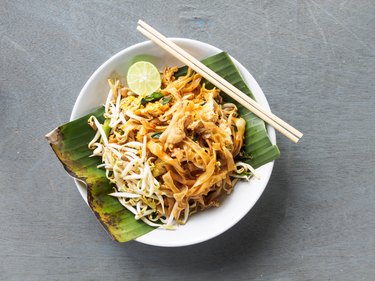
Pad Thai is a popular street food in Thailand. When it comes to healthy Thai food, pad Thai nutrition shows that it can be a good option. Though it can be made in a variety of ways, many variations are high in calories, fat and sodium.
What Is Pad Thai?
Video of the Day
According to Pomfret Recreation, pad Thai is a Thai dish made with stir-fried rice noodles. It also contains a variety of additional ingredients such as egg, peanuts, bean sprouts, chicken or shrimp. It does not contain coconut milk, making it a healthier option than green curry and other curry dishes.
Video of the Day
According to Gastronomica, pad Thai is nothing more than a noodle dish, one that has Chinese origins. Though no formal dietary studies of pad Thai have ever been conducted, in the 1940s, the Thai government promoted it as a healthy Thai food.
The beauty of pad Thai calories is that you are in control of the ingredients, so you can make it the way you want to. There's a basic recipe with no set ingredients. That's why when you try it from one restaurant, you may find it is completely different from what you've had in the past from another restaurant.
Pad Thai Nutrition
According to the USDA, 1 cup of meatless pad Thai provides:
- 328 calories
- 12 grams of protein
- 18 grams of fat
- 32 grams of carbohydrates
- 3 grams of fiber
- 9 grams of sugar
- 128 milligrams of calcium
- 2 milligrams of iron
- 58 milligrams of magnesium
- 172 milligrams of phosphorus
- 242 milligrams of potassium
- 692 milligrams of sodium
The USDA information for 1 cup of chicken pad Thai indicates that it contains:
- 306 calories
- 18 grams of protein
- 14 grams of fat
- 29 grams of carbohydrates
- 3 grams of fiber
- 8 grams of sugar
- 40 milligrams of calcium
- 1 milligram of iron
- 50 milligrams of magnesium
- 180 milligrams of phosphorus
- 322 milligrams of potassium
- 684 milligrams of sodium
And the USDA information for 1 cup of seafood pad Thai shows it contains:
- 290 calories
- 14 grams of protein
- 14 grams of fat
- 30 grams of carbohydrates
- 3 grams of fiber
- 9 grams of sugar
- 66 milligrams of calcium
- 1 milligram of iron
- 54 milligrams of magnesium
- 192 milligrams of phosphorus
- 252 milligrams of potassium
- 700 milligrams of sodium
Read more: The Benefits of Sweet Tamarind
Healthy Thai Food Options
Watching your waistline? That doesn't mean you have to completely avoid Thai food. You can control the pad Thai calories by swapping the rice noodles for zucchini noodles. If you want to bulk up the dish to make it more filling without adding too many calories, double up on vegetables.
Or, if you want to make red or green curry, you can use light coconut milk that doesn't have as many calories. Because of the fat content in coconut milk, though, it's best to eat dishes like this in moderation and opt for other entrees.
To reduce the number of pad Thai calories in your dish, skip the stir-fried rice noodles. Opt for more vegetables and a moderate amount of lean protein for a healthier meal. The American Heart Association recommends asking that MSG be left out of your dishes if you're watching your sodium intake. When done right, pad Thai nutrition can make it one of the healthiest options on the menu.